For most of us in the Western world, a trip to the fruit section of the grocery store is pretty mundane. Bananas…apples…maybe a mango if we’re lucky. Even some trendy farmer’s markets are pretty limited to whatever is local. Exotic fruits just aren’t available everywhere.

But there is an absolutely massive number of exotic fruits out there than you may have never seen before! I’ve listed 98 of them here. Even if you do recognize a few of them, some of these guys you can only get on certain continents, or cost a crazy amount of money and are only available from specialty stores in trendy US cities. For example, I bought a single Kiwano fruit the other day for $6.00 USD!
If you could pick just one to try, which one would it be? I’d love to try the cucamelon because it looks just like a mini watermelon 🙂 Also, if fruit isn’t doing it for you, why not try out some unusual vegetables instead?
Big List Of Exotic Fruits!
Lucuma

According to Peruvians, most people don’t actually eat this fruit, but they really enjoy the flavor of it in other things. The texture isn’t very pleasant according to the people I asked, but it’s sweet!
They put it in cakes, pies, pastries, puddings, ice creams, and other sweets. Actually, my first time learning about it was in a local Starbucks! You can’t get this in the USA for sure! I usually don’t drink Frappuccinos, and it was way too sweet for me. I couldn’t finish it. But I saw tons of people order it, so it must have been popular. The chirimoya (white one) is featured lower on this list as well.

Pacay / Guama (Ice Cream Bean)

The other fruit, which really impressed me, was the ice cream bean, also known as pacay. The first time I saw this fruit was in the famous restaurant called Centrale. It’s one of the most popular restaurants in the world, and you normally have to make a dinner reservation 4 months in advance. Well, I snuck in at lunch and found a spot. Lucky me! One of the courses was an ice cream bean.
Unfortunately, it was shockingly expensive there, and cost me about $150 for the whole meal, meaning my single “bean” cost about $20 (not even the whole pod!)
Then I continued to travel, and had it for breakfast again at a small hostel. There, it cost me about $0.20 for three beans. The consistency is a bit weird, but delicious. It looks like a styrofoam packing peanut, but has a cotton candy texture. It’s sweet, but not overly so. It kind of squishes in your mouth similar to cotton candy as well.
Chayote

Chayote belongs to the same family as squash, melons and cucumbers and the plant is native to Mexico, where it grows abundantly. The fruit can be eaten raw and is sometimes used in salsas or salads, although most of the time it is marinated in either lime or lemon juice first.
Most of the time however, the fruit is lightly cooked, which helps to keep the texture of the fruit. The skin does not need to be removed prior to cooking.
Fuyu Persimmon

Persimmons are often referred to as ‘the fruit of the gods’ and there is a fair amount of history and mythology that surrounds the fruit. However, it can also be a bit controversial, because many varieties need to be very soft before they can be eaten.
The Fuyu persimmon is the most accessible variety of persimmon because it is non-astringent. This means that it is sweet and tasty when the fruit is firm.
Durian

Durian is one of those foods that people either love or hate. Inside the thorny exterior is a soft creamy fruit that has an incredibly intense aroma. In fact, you can often smell the fruit even when the shell is intact.
Descriptions of the taste vary considerably, but one example is that the fruit tastes like ‘rotten mushy onions’. Despite this, there are many people who are fanatical about the fruit and even competitive eating contests that focus on its consumption.
Pomelo

As appearances suggest, pomelo is a citrus fruit and it originally comes from Southeast Asia. When ripe, the fruit is yellow or pale green and tends to have white flesh and thick rind.
The taste is like a sweet grapefruit and it lacks the bitterness normally associated with grapefruit. However, the fruit does still have the potential to interact with some medications in the same way that grapefruit does.
Starfruit

Starfruit is a type of tropical fruit that is rapidly becoming popular in the United States. The shape of the fruit means that when it is sliced, the section forms five-pointed stars (although in some cases fruits may have a slightly different shape).
The flesh of the fruit is crunchy and juicy, and the taste can vary considerably across the fruit. Ripe fruit can be eaten raw (in their entirety), while unripe fruit are sometimes used in cooking.
Kiwano, AKA African cucumber/horned melon

Even from the outside, the kiwano looks a little odd, and from the inside the fruit is even more confusing. The flesh itself actually tastes a combination of kiwifruit, zucchini and cucumber, which is an odd combination that also seems to be quite appealing.
Eating the fruit is simple, you simply cut it in half and squeeze the green ooze out, or you can eat it with a spoon. The pulp is also good as a garnish, in fruit salads or in drinks.
Atemoya

The atemoya is actually a hybrid of two different fruits, which are cherimoya and the sugar-apple, although most people probably haven’t heard of those either.
Even though it looks resilient, the fruit is easily damaged, so it needs to be handled carefully. While the flesh of the fruit is edible and delicious, the seeds are not safe to eat and should be avoided.
Black Sapote

For just about any other fruit, a brown or black interior indicates that the fruit is past its best, but that’s not true for the black sapote.
Instead, the interior looks like this when the fruit is ripe and ready to eat. The texture, taste and color of the fruit have all been associated with chocolate pudding, which makes the fruit both appealing and highly unusual.
While a real chocolate pudding might still be more appealing, the fruit has the advantage of being much better for you.
Buddha’s Hand
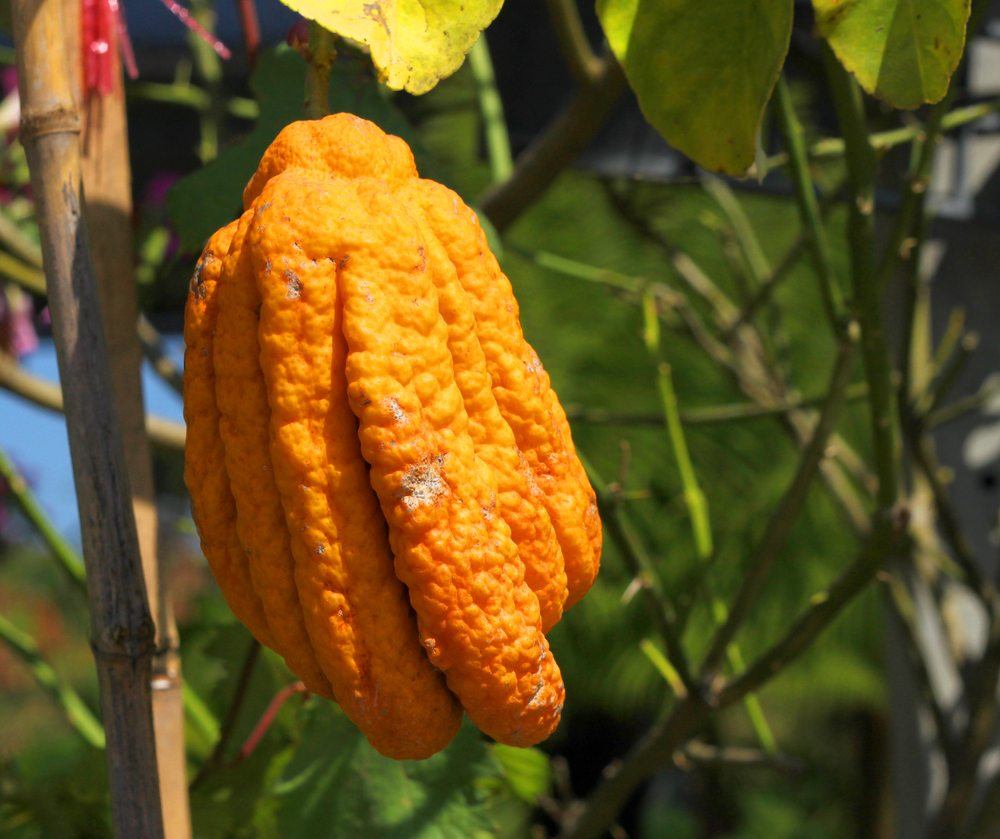
Multiple different varieties of Buddha’s hand exist, often with considerable variation in the way that the ‘fingers’ are held. In some varieties, the fingers are close together (as in the images), while in other varieties they are splayed out in an open hand pattern.
The use of this fruit is largely ornamental, both because of its appearance and because of the aroma of the fruit. However, the fruit can be eaten, and is sometimes used in desserts and in savory meals.
Canistel AKA Tiesa

Canistel is one of a few fruits in the world that isn’t juicy or particularly easy to eat. The fruit has a very chewy consistency that borders on chalky, and it is easy for some of the fibers to get stuck in your teeth.
At the same time, the taste of the fruit is reminiscent of a sweet potato, although it does tend to be a more intense flavor. When eating this fruit, you want to be sure that it is ripe.
This occurs when it gives in easily to a little pressure from your thumb (much like an avocado) and when the skin is entirely yellow.
Cucamelon

Cucamelons are incredibly cute tiny fruit that look like baby watermelons from the outside. They are considered savory fruits and taste more likely cucumber with a little lemon juice than like an actual melon.
The fruit works well in savory dishes, like stir-fries, and they also work well raw in salads or salsas. Or, you can just pop them in your mouth as-is.
Feijoa

Feijoas mature in autumn and are a sweet fruit with flavors of mint, pineapple and apple. They are commonly eaten but cutting in half and scooping out the interior with a spoon, although the fruit is also a particularly good in smoothies because of its complex taste.
Feijoas are most commonly cultivated for food in New Zealand and they tend to be hard to find and expensive in many other parts of the world, including the United States.
Soursop AKA Guanabana

The inside of the soursop has white pulp along with black seeds that cannot be digested.
The flesh itself tastes like a combination of pineapple and strawberry, along with some more sour citrus elements. This makes it a common choice for smoothies and fruit juice drinks.
Debate has focused on the potential health benefits of the fruit, including its potential to reduce stomach pain, inflammation, help relieve respiratory issues and even for fighting cancer. However, most of these claims need much more research before they can be verified.
Cherimoya

Cherimoya is thought to be one of the best tasting fruits in the world and has a creamy texture. This texture also means that the fruit is enjoyable when chilled and then eaten with a spoon.
Descriptions of taste vary, but most focus on cherimoya tasting like a combination of other fruits, including banana, strawberry and pineapple. The fruit has a very short shelf-life, which is one reason why it is so hard to find.
Jabuticaba

Jabuticaba is an unusual case of a fruit that grows directly on the trunk of the tree. The fruits can be eaten straight off the tree and grow to around 1.5 inches in diameter.
Often the fruit is used in a similar manner to grapes, which is why some parts of the world also have jabuticaba wines and liqueurs.
Jackfruit

This is a tropical fruit that is most commonly produced in Vietnam and Thailand, with a flavor that resembles a mix of other fruits, including banana, mango and pineapple.
Sometimes the flavor is also described as similar to Juicy Fruit gum. The fruit is also high in vitamin B, potassium and protein, making it a particularly healthy but severely underutilized crop.
Gac AKA Baby Jackfruit

From the outside, gac does kind of look like a baby jackfruit, but visual appearance is where the similarity ends. The fruit has a very short harvest season, making it a relatively rare food.
Because of this, it is often used for festive or ceremonial occasions, rather than as an ingredient. One common dish from the fruit involves cooking the flesh and the seeds in rice, resulting in a bright orange rice dish.
Dietary supplements from the fruit have also been produced as it offers a high amount of phytonutrients.
Calamansi Lime

Calamansi limes are best described as a mix between a lime and an orange. This gives them a strong citrus fragrance and they also tend to have much more juice than limes typically do.
Despite this, they still have that sour tartness of limes and they can be used in the same way as a lime. The limes are often green and tend to be relatively small, however, you can also find them with orange skin, which causes no end of confusing for the unwary shopper.
Cempedak

The cempedak is a close relative of the jackfruit, and interior structure of the two fruits is similar. The individual pulpy pieces can be eaten straight out of the fruit as-is, and the flesh is a less sweet version of the jackfruit.
The fruit also has a very strong smell and you can smell it from quite some distance away. Opening a cempedak needs to be done with care, as doing so releases a sticky juice that you need to use an oil-based product to remove.
Langsat

Langsats are orb-shaped fruits that look a little bit like a small potato when the skin is on, although the inside of the fruit is an entirely different matter. When ripe, the fruit is sweet and tastes a little bit like a grapefruit.
The simplest way to eat the fruit is to peel off the skin and eat it out of your hands, although the fruit can also be cooked. Two main varieties of langsat exist. One of these is thick skinned and the other is thin skinned, although both taste good.
Lychee

The lychee is a sweet summer fruit that comes from the soapberry family. The outer rind of the fruit is inedible, but it is easily removed to allow access to the white flesh inside.
The fruit is known for its floral scent, although this scent is lost when the fruit is canned, making the fresh fruit a more popular option. Lychees are also common across a number of different desserts.
Loquat

The loquat resembles an apricot, and like an apricot, the yellow flesh of the fruit is the part that is eaten.
Unusually, loquat trees flower in autumn or the beginning of winter and fruits ripen in winter itself or at the start of spring. The fruit is best if picked when the fruit is entirely yellow, but before it starts to go orange, as the yellow stage is where the flavor is the most intense.
The fruit does also have a very thin skin, which can be removed. However, removing the skin can be challenging and messy, so most people simply don’t bother and use it as-is.
Mangosteen

The mangosteen has an interesting history. Despite the fruit’s popularity, it was illegal to import them into the United States for a long time, because there were fears that the fruit contained the Asian fruit fly.
They are now available and the best place to source them tends to be Asian specialty food stores. At the same time, there has been a growing interest in the juice from the fruit, which has been associated with a number of health benefits.
How many of these are real remains to be seen, as research into the fruit and its juice continues.
Monstera Deliciosa

Monstera deliciosa is another tropical fruit, although this one looks a lot more like an ear of corn than it looks like a fruit. The green scaly exterior of the fruit is tough and inedible, and it is the white flesh beneath this that people eat.
That flesh has a similar texture and taste to pineapple, although there are also some similarities to the jackfruit in terms of taste. The fruit should only ever be eaten when it is completely ripe, as the unripe fruit can irritate and cause adverse reactions.
Noni Fruit

The noni fruit is a native of Australia, Asia and the Polynesian islands. The fruit is roughly the size of a mango and is normally eaten for its potential health benefits, rather than its taste.
Many different health claims have been made about the fruit, although little has been proven. Nevertheless, the high antioxidant content of the fruit suggests that it may offer some benefits. The juice from the fruit is bitter, so people tend to use it as part of a fruit juice or smoothie, so the taste can be masked.
Another alternative is to add a dash of lemon juice and drink noni fruit juice like a shot.
Pitahaya AKA Dragon Fruit

There has been a lot of popularity surrounding dragon fruit drinks and dragon fruit flavorings in recent years, but the fruit itself tends to get overlooked.
The white flesh of the fruit along with its black seeds are the part that you eat, as the skin itself cannot be eaten. The seeds have a nutty taste while the flesh of the fruit is sweet. Altogether, the flesh and the seeds go well together and can be easily scooped out of the skin and eaten.
Poha Berry, Physalis, Cape Gooseberry

The yellow-orange fruit of the cape gooseberry grows inside of thin papery husks that are incredibly easy to remove. The fruit grows to roughly the size and shape of a cherry tomato, although the color and interior of the fruit is very different.
The taste is best described as an appealing cross between tomato and pineapple, and they are commonly eaten dipped in chocolate.
Rambutan

You wouldn’t know from looking at it, but the fruit of the rambutan is actually a sweet and white oval. The fruit can be easily opened either by cutting into the rind or by making an incision with biting, as the spines themselves do not hurt and are harmless.
From there, the outer rind of the fruit can be peeled off to reveal the soft flesh. Doing this can also release some juice, which is as sweet as the fruit itself.
Rollinia Deliciosa AKA Birbia
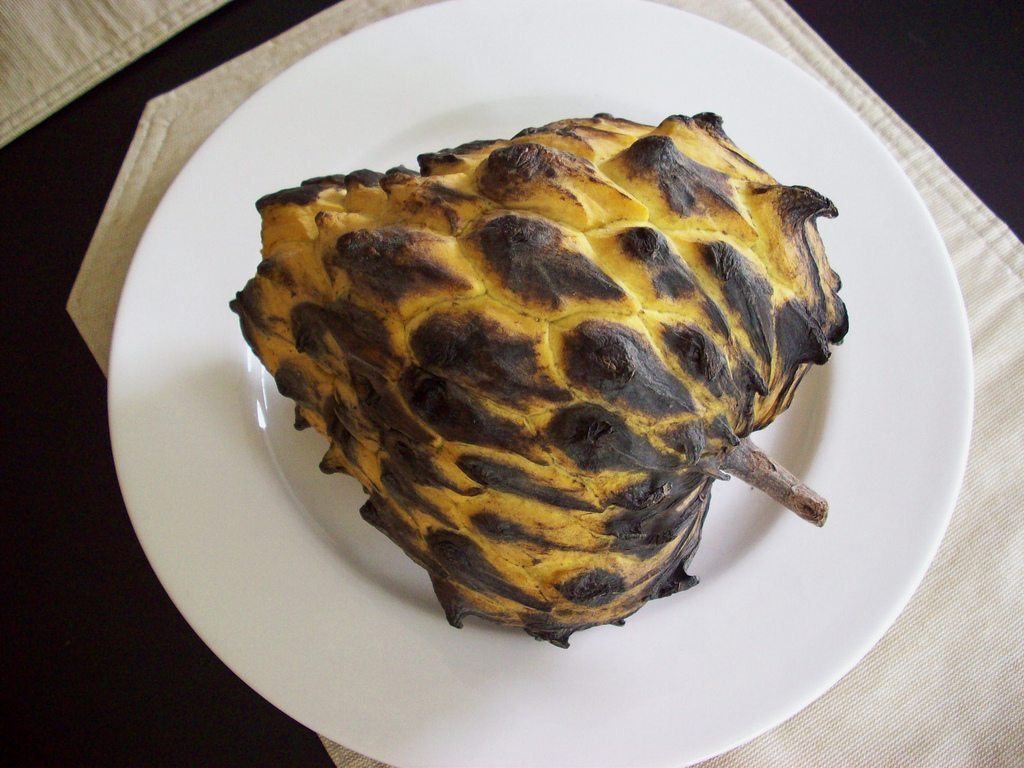
Like many other members of the custard-apple family, birbia doesn’t look all that much like a fruit from the outside. The outside of the fruit is yellow as it ripens, but the spines taste on a black appearance when handled, which can make the fruit look very unappealing.
However, the interior of the fruit is a different story, and tastes a little bit like a lemon meringue pie. The fruit does have an incredibly short shelf-life, which makes it very hard to find.
Rose Apples

The rose apple goes by a host of names, including mountain apple and wax apple. Yet, despite these names, it isn’t much like an apple at all. The main feature in common in the waxy red skin.
Beneath this skin, you have a surprisingly moist fruit with a sweet and floral flavor. This floral flavor is reminiscent of a rose, which may be where the fruit gets its name from. Still, you can bite into rose apples just like you would regular apples. However, the seeds of the apple are inedible, so these need to be avoided or spat out when eating the fruit.
They’re often used in cooking and preserves as well.
You may notice different colors and flavors for this fruit, including some that are lighter and have a more rose-like flavor. This is because there are multiple varieties, which vary in the flavor and color of the fruit.
Salak (or Snake Fruit)

It’s easy to see why many people refer to this as snake fruit. The little fruit is covered with tiny scales, which look much like the ones you’d find on a snake.
Salaks might be rare in the United States, but they are particularly common in Indonesia. The fruit is roughly the size of a strawberry and has a complex taste that includes honey, citrus, and pineapple.
The texture of the fruit is spongy, which is a bit unusual for people who aren’t used to it. Despite this, it is a fruit that people quickly come to love and it is easy to eat straight out of its rind.
Yet, the fruit itself is delicious. Tourists sometimes find them eating one piece of fruit straight after another, delighted at the texture and flavor profile.
Santol

The santol is an unusual fruit that has a very thick skin, with white segments of flesh inside. The fruit itself is a mixture of sweet and sour, which can be appealing to some and not to others.
The most common way to eat the fruit is to suck the flesh from the seeds, as the pulp from the fruit sticks strongly to the seeds. You do need to be careful not to swallow the seeds in the process.
Sapodilla

The sapodilla is known for its unusual taste combination, which is said to be a mixture of root beer and brown sugar. Because of this, the fruit is commonly eaten as a sweet treat. The texture of the fruit most closely resembles a pear, although botanically it is considered to be a berry.
Custard Apple
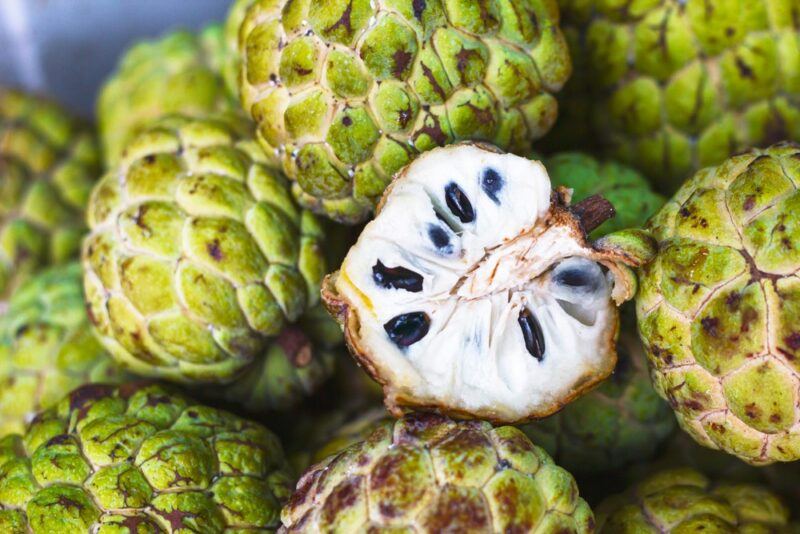
The custard apple seems to get its name from the flesh of the fruit, which has a mild and sweet taste that resembles traditional custard. There are several varieties of custard apple, with the most common being African
Pride and Pink Mammoth, with the latter being a considerably bigger fruit. Although they are relatively uncommon, custard apples can be found in the United States, and are a sweet treat for those lucky enough to find them.
Ugli Fruit

The ugli fruit is a citrus fruit, created from the hybridization of tangerine, orange and grapefruit, and the fruit hails from Jamaica. Unusually, the name ugli itself is actually trademarked, but it is a suitable name, as it has a more misshapen and less appealing appearance than most traditional citrus fruits.
Yangmei

The yangmei fruit is extremely common in China and is frequently eaten raw and used in creating alcoholic drinks. However, it is much less common outside of China, because the fruit is very perishable, making it challenging to transport.
The fruit is small, slightly larger than a cherry, and has a similar taste and texture to a strawberry. Even where the fruit is common it can often be expensive, as it has to be chilled from when it is harvested onwards.
Prickly Pear

While many people have heard of the prickly pear cactus, few realize that the fruit of the cactus is edible. If you find them in the market, the worst of the hair-like thorns will probably have been removed, but if you find them wild, eating the fruit without hurting your hands can be quite challenging.
While the fruit itself is popular, many people prefer the juice, which can be obtained by liquefying and then straining the flesh of the fruit.
Longan
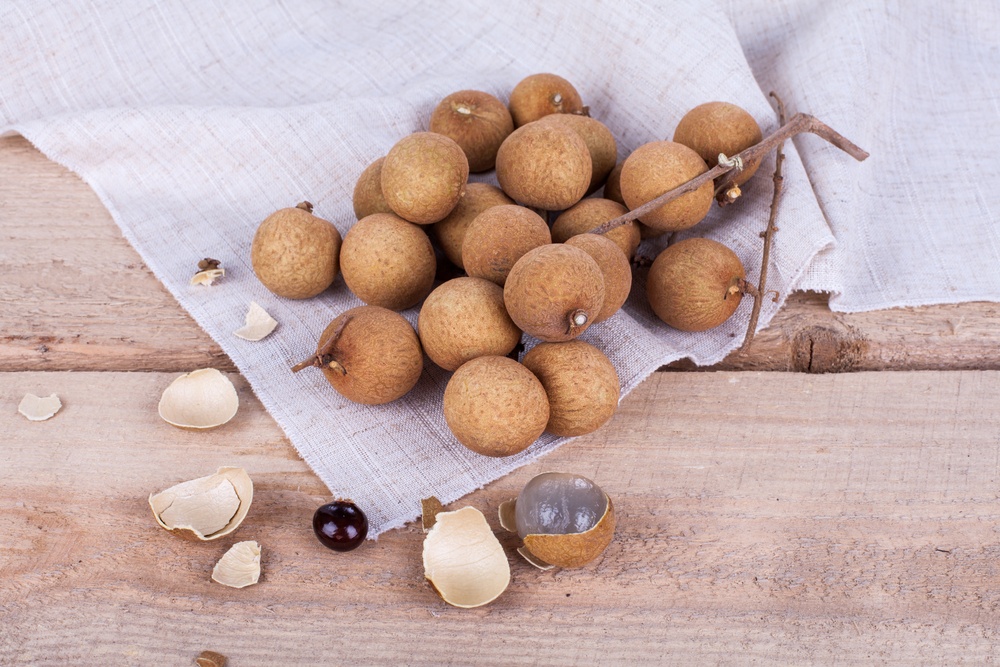
Like the lychee, the longan comes from the soapberry family, although it is not as well known. The shell of the fruit is both firm and thin.
This makes it easy to get the fruit out of the shell simply by cracking the shell apart. The fruit also has the name Dragon’s Eye, because of the way the fruit and its black seed resemble an eye when cut in half.
Wood Apple, Bael, Stone Apple

The wood apple seems to get its name from the very hard rind of the fruit. This rind makes it challenging to get the fruit open and the rind is also often used as an ashtray or a bowl.
The flesh of the fruit can be eaten as-is and is often scooped directly out of the rind. It can also be used in a range of other ways, such as scooped out and frozen.
Breadfruit

An interesting thing about the breadfruit is that it can be eaten in multiple different stages of development.
When the fruit is mature, it can be eaten raw and has a sweet and creamy taste, making it a good option for desserts. It also makes a good substitute for most starchy vegetables, like potatoes, and mature breadfruit can actually replace potatoes in many recipes.
Water Apple

The water apple is a tropical fruit and despite its name, the fruit isn’t actually considered to be an apple. The fruit itself is relatively small and tends to be less than an inch in length.
It has a relatively mild or faint flavor, which resembles an apple, however, the texture of the inside is more similar to a watermelon.
Nipah Seeds

Nipah seeds come from the nipah palm. This is a particularly versatile species of plant and most parts of the plants are used for different purposes, such as the sap being tapped or the young shoots of the pam being eaten. The fruit is also sometimes used as an ingredient in desserts.
Pulasan

Visually, pulasan looks a lot like rambutan, and the two tropical fruits are often confused with one another.
One difference between the two species is that the seed of the pulasan can be safely eaten raw, and it has a similar taste to almonds. The plant is native to Malaysia, and the fruits are rarely found outside of Southeast Asia.
Kaffir Lime

Also called the makrut lime, this type of lime has a bumpy outer skin. Most of the time, it is the zest of the fruit that is used in a large range of traditional dishes and the juice of the fruit is considered too acidic for food.
There has also been considerable controversy surrounding the name kaffir lime, as the word kaffir is considered a racial slur in many parts of the world.
Platonia AKA Bacuri

With a mottled yellow-brown outer skin, the bacuri fruit is unlikely to win any beauty contests. Yet, despite this, the flesh of the fruit is surprisingly tasty and achieves a good combination of both sweet and sour.
The fruit is largely eaten fresh, although are a few other uses, such as creating jams and jellies from the fruit.
Duku
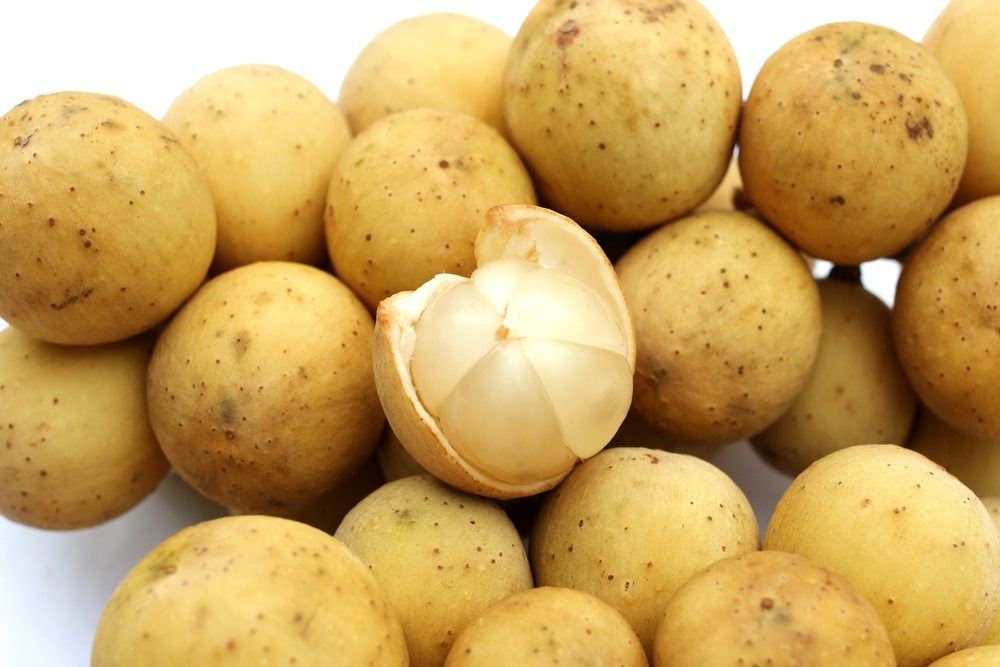
Duku is actually a member of the same species as the fruit langsat. However, the two are considered to be different cultivars.
Species that fall under the duku variety tend to have thick bright green leaves with bunches that contain just a few fruit. The fruit themselves tend to be large and round with thick skin.
Pitanga AKA Surinam Cherry
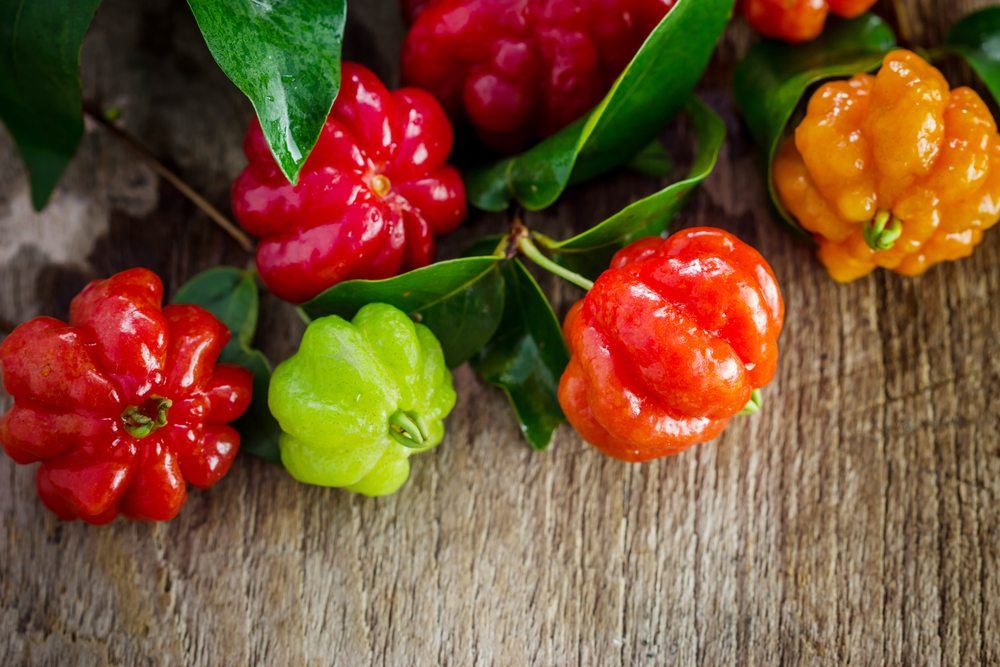
Technically, the Surinam cherry isn’t actually a cherry and the fruit doesn’t even look that much like a cherry. They are also a bit of an acquired taste, especially as they don’t actually taste anything like a cherry.
They should also only be eaten when they are completely ripe. At that time they are a deep red color. Fruits that aren’t as ripe won’t necessarily make you sick, but you will regret trying anything even a little bit less ripe.
Safou
One of the most distinctive features about safou is the way that the fruit have a texture like butter when they are cooked. This texture is why the fruit is sometimes referred to as butterfruit.
The fruit is particularly significant as it is high in calories and in fat, while it also contains a significant number of nutrients. This is particularly important for areas that have limited food and it can be a key resource in reducing hunger.
Salmonberry

Visually, salmonberries look a lot like raspberries. However, their color (not their taste) is often a salmon color. The coloration of the fruits can range though, and you can see fruits anywhere from pink to dark red.
The fruit doesn’t have the sharpness that you find in raspberries, but the taste is still appealing. The orange fruit tend to have the most flavor, while the more red fruits are often disappointing in terms of taste.
Star Apple
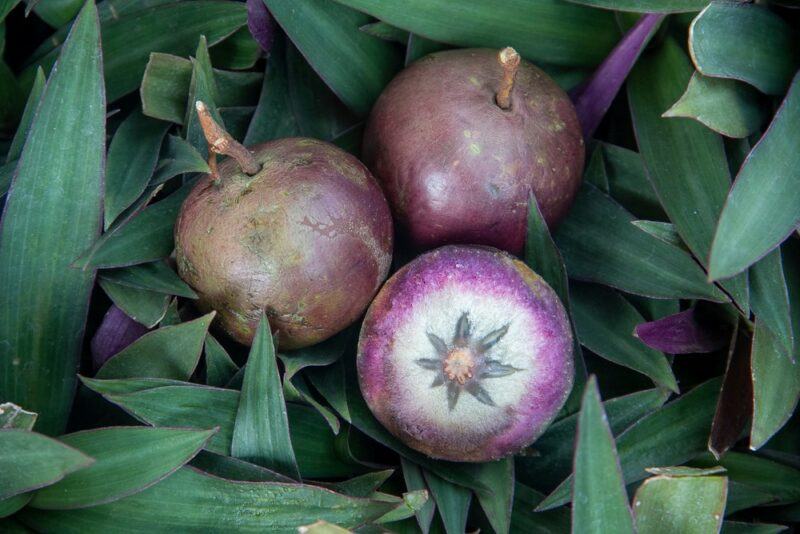
What do you think of this little beauty? The start apple comes from the tree Chrysophyllum cainito and is named for the distinct star shape seen when the fruits are cut in half.
Despite the name, you can’t eat these like a traditional apple. The skin and the rind are both inedible and need to be removed before you can enjoy the fruit.
The texture is interesting too, as the flesh of star apples is soft and a little like jelly. They’re best served chilled and can be delicious as a flavoring ingredient as well.
Miracle Fruit

Surprisingly, the name miracle fruit is entirely accurate. This unusual berry is significant because glycoproteins within it bind to the taste buds on the tongue.
The end result of this is that for roughly an hour, any other food you try will be distorted into having a sweet taste. This feature of the fruit can create whole new taste. This effect means that you could eat the fruit and then eat a lemon, and that lemon would taste sweet.
Strawberry Tree AKA Arbutus unedo

Despite the name, the strawberry tree doesn’t actually produce strawberries (those don’t grow on trees). Instead, they produce a berry that is red when it is ripe.
The fruit can be eaten and has a sweet taste that some consider similar to a fig. In general though, the taste of the fruit is considered unremarkable and it is not widely popular.
Finger Lime

Australian finger limes are a particularly unusual type of citrus fruit. The fruits have been becoming increasingly popular as a type of gourmet food, and have also been referred to as lime caviar.
The little bulbs within the fruit contain juice that tastes similar to a common lime. These burst when chewed, which makes them an appealing garnish to many dishes.
Medlar

The best time to eat medlar is when the fruit has become extremely soft. When this happens, the flesh of the fruit feels and tastes like a form of fruit butter (which is more appealing than it sounds).
When it is at that stage, the fruit can be challenging to eat, but one approach is to simply create a hole in the skin and suck out both the seeds and the flesh through that hole.
Cloudberry

Cloudberries tend to be a soft and juicy taste. When they are ripe, they have a tart taste that many people find appealing. They are also often eaten when they are overripe.
At that point, they have a more creamy texture and they also taste sweeter. Cloudberries are frequently used to make products like juices, jams, and tarts, and also make a fantastic topping for foods like ice cream and pancakes.
Crowberry
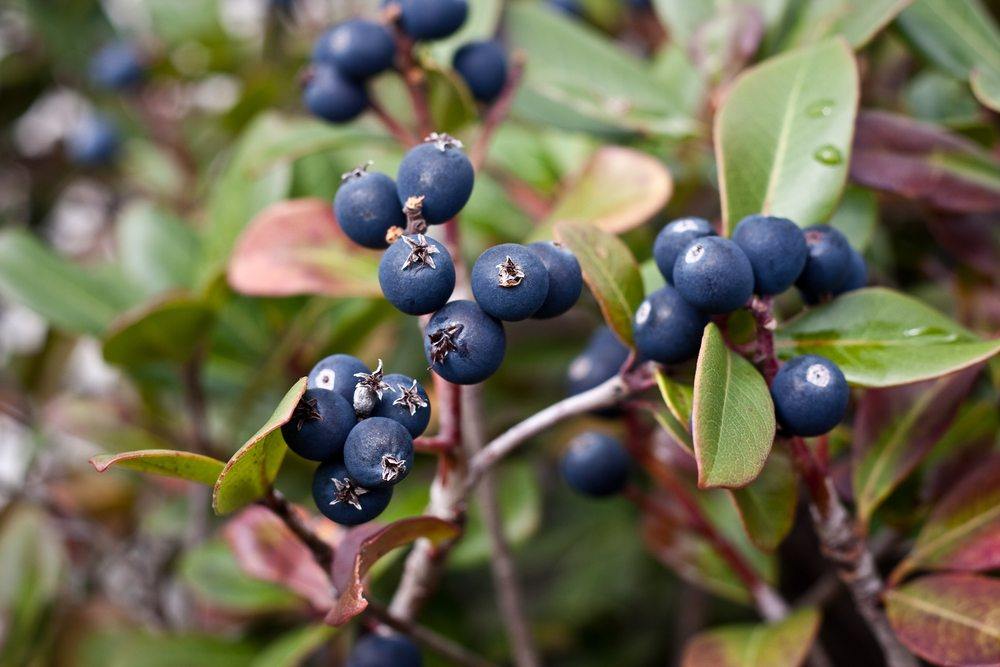
The crowberry isn’t a particularly popular type of berry, but there is growing interest in using it as an edible fruit.
Traditionally, crowberries have been paired with meals like dried fish, sour milk and roe, as the berry is tarter than many other types of berries. It is also best used cooked and the taste tends to be unappealing when the berries are eaten raw.
Imbe

Imbe is a relative of the African mangosteen, although it is not as well-known. The fruit resembles an apricot, with one large seed per fruit, although the amount of edible material per fruit is relatively small. The fruit has a pleasant sweet taste that is similar to apricots.
Natal Plum

The natal plum is a particularly delicious fruit, yet the plant is from a highly deadly family, which makes people steer well clear of it.
A key member of that family is oleander, which is often responsible for fatally poisoning people. Additionally, the fruit is the only part of the natal plum plant that is safe to eat – something that does not exactly help the reputation of the fruit.
Honeyberry

Honeyberry plants produce these unusual elongated blue berries that look almost like someone has taken a blueberry and stretched it out. The berries are zesty, with a thin skin, and are easily eaten.
However, there is a lot of debate on what precisely the berries taste like. A range of flavors have been attributed to the fruit, such as cherry, kiwi or blackberry. Despite this, the simplest explanation may simply be that the fruit has its own unique taste.
Barrel Cactus

Yikes! That looks dangerous. But those are often the most delicious. Here are some tips for eating and cooking barrel cactus fruit.
Saguaro

Saguaro is a cactus species that is particularly common in Arizona, although it is also found in other parts of the United States and further afield.
The cactus grows bright red fruit that have to be harvested using a stick because of the spines of the cactus. Most of the time the fruit is used to make a syrup, which is a particularly rare type of syrup.
Cupuacu

Cupuacu comes from the same family as cocoa and is commonly used to create a new kind of ‘chocolate’, one that uses cupuacu beans instead of traditional cocoa beans.
This creates a chocolate alternative that is appealing to many, especially people who are trying to move away from cocoa. It is an interesting alternative to chocolate, with a more complex taste that isn’t quite what you expect from standard chocolate.
Pepino Melon

Despite its appearance and name, pepino melon isn’t actually a melon. Instead, the fruit is related to the nightshade and has a flavor that is a combination of the flavor of honeydew and of cucumber.
The fruit is frequently used raw, such as part of a salad or simply eaten as-is. Many varieties of the melon have yellow instead of purple skin, but still retain the distinctive purple striping.
Pandanus (from the Screw Pine tree)

The screw pine tree is a particularly common type of tree in many Pacific coastal regions. The fruit can be a bit tricky to eat, as you need to remove the individual fruit pieces (called keys).
Often the first key or two needs to be removed with a hammer, but the rest can be removed by hand. This makes for a tricky process, but the fruit itself can still be appealing.
Akebi

Akebi has the appealing nickname of chocolate vine, which tends to get people’s attention relatively quickly, although the fruit certainly doesn’t taste like chocolate.
Instead, the pulp of the fruit is relatively mild and tends to have a very slight coconut flavor. The fruit has a very short fruiting period. This means that it isn’t very widely available and can be difficult to find.
Ackee

The ackee is another member of the soapberry family, much like the longan and the lychee. It is a tricky fruit to eat, because if it is not eaten properly, the fruit can lead to vomiting, a coma or even death.
The only edible part of the fruit is the yellow flesh that surrounds the seeds. This part can also only be eaten when the fruit has turned red and split open. However, some who have tried the fruit do claim that it is worth the risk. That said, you should always cook the fruit, rather than eating it raw.
Achiote AKA Bixa orellana
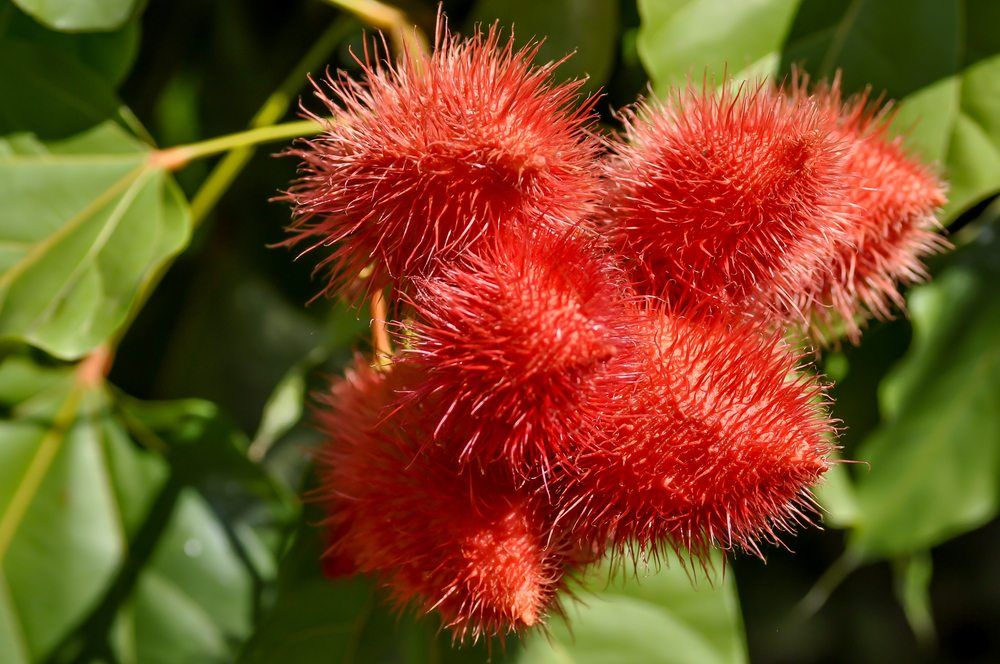
For cuisine, the most significant aspect of the achiote tree is the compound annatto, which is extracted from the seeds of the fruit.
Often, these seeds are ground to produce a paste or powder that is used in many recipes. Likewise, the extracted annatto is used as a spice and it is also commonly used to give a yellow color to food, such as rice.
Genips (Spanish Lime)
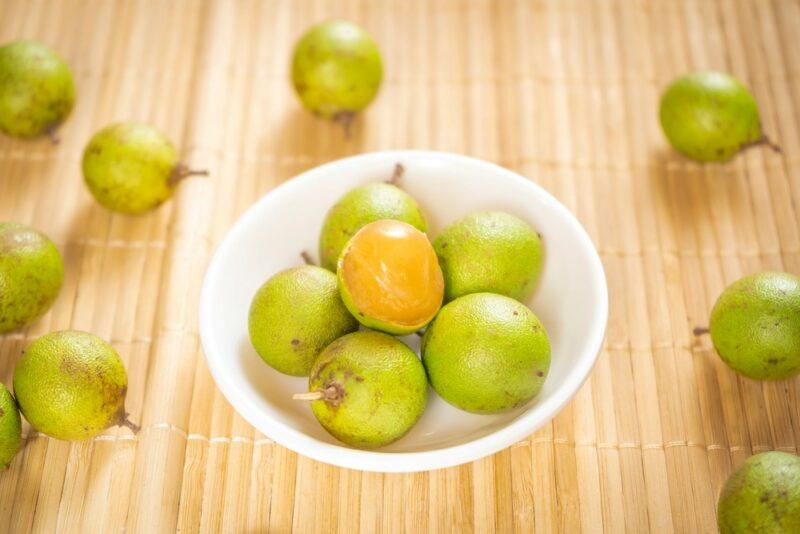
Tangy flavor, sometimes sweet. The pulp is creamy. It can be eaten fresh, or made into jams/jellies, and limoncello!
Jenipapo

Interesting information can be found about this Brazilian fruit here. Apparently it smells like overripe bananas and can be dried, then made into ink!
Jambula

Also known as syzygium cumini, it’s got a sweet and sour taste, and is used for medicine in some African countries. It may have some anti-diabetic properties.
Jujube (Chinese Date)

Jujube is very much like a date. You can eat it fresh, or dry it like the dates which are commonly found in the USA. A flavor compound spinosin found in jujube can be used as a natural sleep aid!
PawPaw Fruit

Pawpaw is not the same as Papaya!
Barbados Cherry

The Barbados cherry also goes by the name acerola or acerola cherry and comes from a tree that can get anywhere up to 20 feet tall. While the fruits themselves are roughly the same size as cherries, they actually contain three small pits rather than a large stone.
The cherries are delicious, with juicy and sweet flesh that contains just a hint of tartness. They’re even tarter if you consume them when they’re underripe.
The flavor is tough to describe. It’s best considered a mixture of other fruits, including cherries, plums, and apples. Some nurseries and specialized sellers in the United States even offer Barbados cherry trees, giving you the chance to grow them yourself.
Ambarella

These interesting fruits go by a host of names, including golden apple, June plum, and Makok faring. While the fruits start off green, they ripen to a golden yellow – becoming sweeter and juicier as they ripen.
That said, ambarella fruits can be enjoyed when they’re green too. In this state, they tend to be somewhat crispy and have a distinct sour flavor.
The fruit is versatile. It can be easily eaten on its own or used as an ingredient in jellies, smoothies, and other dishes.
Ambarella fruits have even been linked to health benefits. They’re thought to help combat premature aging, inflammation, and oxidation, while improving endurance and even bone health.
Jamaican Strawberry
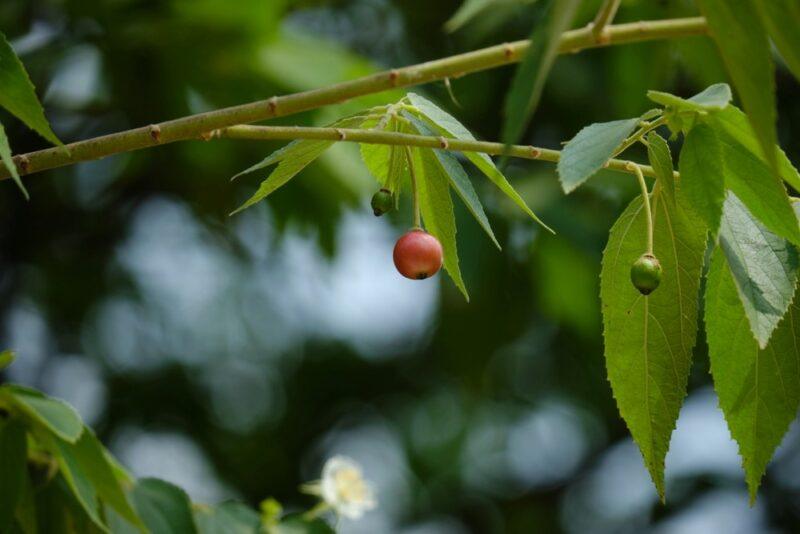
Despite the name, Jamaican strawberries aren’t strawberries at all. That shouldn’t be too surprising, given that strawberries don’t grow on trees anyway.
The fruits themselves look like small lightly colored cherries and have plenty of juicy pulp on the inside. The berries are sweet and delicious, plus they’re packed with vitamin C and antioxidants.
Jocote

This fruit is most often called Jacote or Spanish plum. Although, like most fruits on this list, it has a host of names. While the fruit isn’t common in the United States, it’s often seen in the Philippines, Brazil, and plenty of other locations.
The fruits are green or yellow when unripe. Most develop through to purple or red as they ripen, although a few varieties are yellow even when fully ripe. The fruits themselves are fairly sweet, with yellow flesh and a texture that’s much like a plum.
While jocote is often eaten ripe, this isn’t the only option. Some people eat unripe jocote fruits instead. These are much tarter and have some bitter notes. Because of this, they’re often pickled or used to make a tart sauce. They can also be eaten with salt and chili peppers to offset the flavor.
Babaco

These strange looking fruits are actually natural hybrids, thought to be related to the mountain pawpaw and the chamburo. Oddly, the plant only produces female flowers and no seeds. Because of this, it needs to be cultivated by hand, often through the use of cuttings.
The fruits taste like a combination of pineapple and pawpaw, plus some subtle notes of strawberry and banana. However, the fruit is relatively low in sugar, so it doesn’t taste as sweet as you might expect.
This isn’t a fruit you’ll often find in markets and stores, as babaco has soft skin that’s easily damaged. It couldn’t survive the handling and storage steps needed for a commercial crop, so is most often grown by home gardeners and naturally thrives in subtropical environments.
Naranjilla

Naranjilla is also known as lulo and the plant is popular throughout Central America. It’s a juicy fruit with membrane walls that separate each section. The flavor is distinctive too – like a delicious cross between lemon and pineapple. The lemon flavor notes mean that this is a fairly acidic and tart fruit, one that is popular for its juice.
The juice is particularly good as a contrast to overly sweet juices. It also works well in many recipes.
While the whole fruit isn’t commonly found in the United States, it isn’t too difficult to find frozen fruit concentrate or even frozen naranjilla fruit. The frozen concentrate is a great way to try the flavors of naranjilla without trying to grow the fruit yourself.
Sugar Apple

The sugar apple is a fascinating fruit. It comes from the species Annona squamosa and is similar to some of the other fruits we’ve talked about here, including custard apples and atemoya. However, sugar apples are distinct fruits that are particularly popular in tropical regions.
The fruit has a light inner flesh with a decent number of seeds. The flesh really does have the sweetness of an apple, although there are tropical flavors present too, including pineapple. But, it’s the texture that’s most notable, as the fruit has a creaminess to it that’s a little like custard.
While you can eat sugar apple fresh, it’s often better to chill the fruit for a few hours first. Doing so makes the creaminess stand out even more. You can even blend sugar apple flesh with frozen yogurt to create a simple and delicious dessert.
Plus, like other fruits on this list, the sugar apple is packed with nutrients and antioxidants. These make it an excellent way to promote health.
Araza
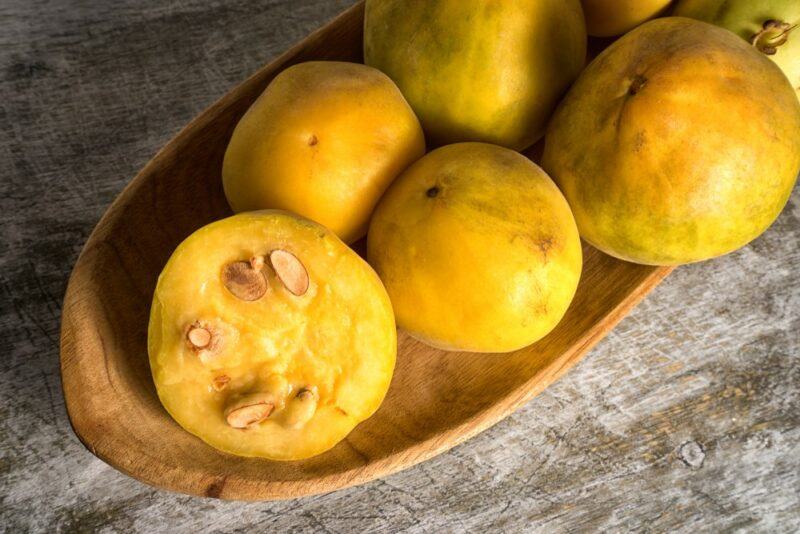
Araza is a rare fruit that comes from some parts of Peru and Brazil. It belongs to the guava family and offers a distinct pulpy flesh. The flavor profile is fascinating, with notes of pineapple and mango, along with distinct tartness.
Because of the fruit’s tart flavor, it is often combined with some type of sweetener before being used in desserts. In fact, the fruit is too tart for many people to enjoy on its own.
This isn’t a fruit you’ll see or hear about often, as the trees are normally only grown within their natural habitat. Still, they grow well in the wild and provide locals with an interesting fruit that is packed with antioxidants.
White Sapote

We’ve talked about the black sapote already. Now here’s a white one. Both fruits look similar from the outside, although the color of their flesh is quite different.
Interestingly, the fruits aren’t related. The black sapote is a species of persimmon, while the white sapote comes from the same family as citrus fruits instead.
The white sapote has plenty to offer, including a custard-like texture and a sweet flavor that’s similar to that of a banana or a peach. However, it’s important to harvest promptly, as the fruit can become bitter when overripe.
Barberry

Barberries have a long history and were once used as part of Indian folk medicine. They’re still associated with health benefits these days too, as they’re a rich source of antioxidants and contain an interesting alkaloid called berberine.
The berries have a distinct tart flavor that makes them exceptional in jellies. Dried barberries are often used in cooking as well. You may even be able to buy them in some local health stores.
Phalsa Berry

Phalsa also goes by the name Indian sherbet berry, which is pretty cool. As that name suggests, the fruit originally hails from India. However, it is found in a variety of other areas. It’s sometimes even grown in warmer parts of Australia and North America.
There are two cool things about this fruit. The first is the flavor, as phalsa berries have a delicious sweet-sour balance. They’re a little like grapes, really, and even look like grapes.
The second is the potential health benefits. Phalsa berries are rich in antioxidants and nutrients – features that could help to promote your health.
Tamarind

Tamarind is a pod-like fruit that has a sweet and tangy flavor. The exact taste depends on the ripeness of the fruit – as it gets sweeter the more it ripens.
It isn’t just used as a fruit either. You’ll often see tamarind extract, concentrate, or paste. These products are made from ripe tamarind and can be used in curries and many other recipes. There’s also tamarind powder, which is an easy way to add a flavor punch to sweets and snacks.
All in all, tamarind is incredibly versatile. This is why it features in so many recipes. You’ll also see the flavor in a surprising number of processed treats.
Balata

Balata fruit can be found in the Caribbean, in South America, and in Central America, but remains a rare fruit. This might be because you don’t get much out of it. Only about 40% of the fruit is edible. The rest of it includes the seed (or seeds) and the fruit’s inedible skin.
Still, if you get the chance to try it, balata can be wonderful. The fruit has soft and juicy flesh, with a flavor that’s both sweet and slightly musky.
Grumichama

These fruits are also known as Brazil cherries, perhaps because they do look much like hanging cherries. The berries grow in clusters and offer a white and juicy flesh, which does taste fantastic.
These are also interesting fruits if you can’t grow regular cherries where you’re living. For example, grumichama trees will grow in southern Florida, while regular cherry trees won’t. That said, the fruits do have larger pits and less fruit than regular cherries, plus the trees are slow growing. So, some patience is required to grow these cherries for yourself.
Yuzu

Yuzu are a pretty famous type of exotic citrus fruit. They offer a blend of other citrus flavors, including limes, mandarins, and even some grapefruit flavors. The fruit is delicious raw and is often used in cooking as well.
While yuzu is easy to find in Asia, it tends to be expensive elsewhere. This is mostly an issue of supply and demand, as much of the yuzu grown in Japan and Korea is used domestically rather than being exported. There are also issues with importing citrus fruits, particularly for customers in the United States.
Marang

This fruit might look familiar, as it’s essentially a cross between jackfruit and durian. The marang has spines that are similar to those of durian, but these tend to be soft, making the fruit easy to open.
The scent is subtle too (much more than with durian!), while the fruit is also creamy and sweet, with a custard-like texture. These features make marang a delicious fruit that’s much easier to enjoy than the durian.
Granadilla

You’ll often see these sweet fruits called passion fruit. That’s not surprising, as there are plenty of similarities and the two are closely related. However, while the passion fruit generally has purple skin, the granadilla is bright orange instead.
Passion fruit also tend to have small black seeds within bright yellow pulp, while the seeds of the granadilla are larger and the pulp is clear rather than being yellow.
Still, the overall texture and flavor profile is similar – allowing you to use whichever fruit you have on hand.
The fruit is even popular enough that some street vendors sell it already peeled, saving you all the hard work.
Rattan Fruit
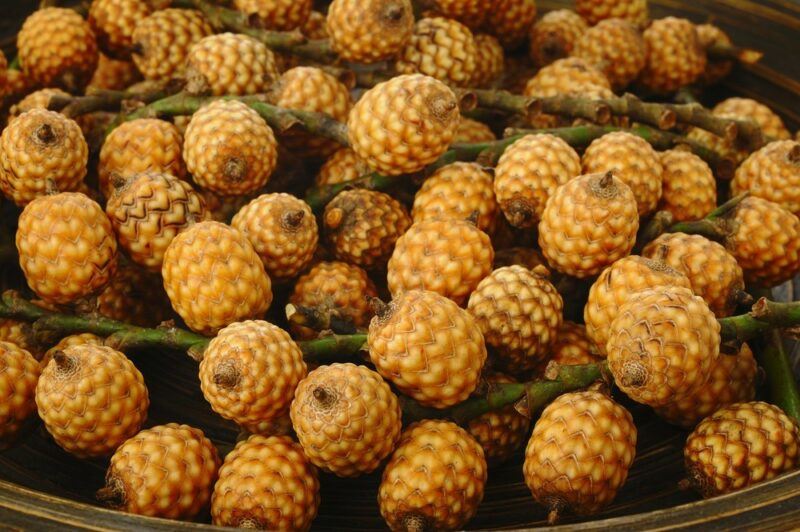
Rattan fruit sometimes goes by the name snake fruit as well, but it has larger scales and isn’t as prickly as the salak. The fruit is found on the rattan pine tree and has a long history of consumption throughout Asia,
Some people eat the fruit raw after carefully peeling it with their fingers or a paring knife. Other times the fruit is used as an ingredient in a stew. It’s delicious either way.
Dalandan
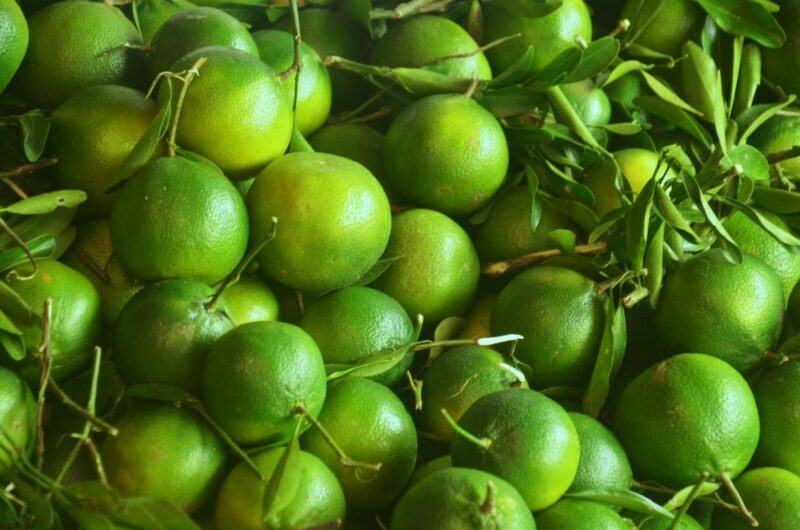
These interesting citrus fruits are popular in the Philippines. They’re notable because the skin is green (even when the fruit is fully ripe), while the interior remains bright orange.
Dalandans are treated much like regular oranges, so they can be eaten raw, juiced, or segmented and used in fruit salads.
Nyii

These small oval fruits also go by the name bird plum. They have slightly wrinkled brown skin, making them look a little like dates. They taste much like dates too and can be enjoyed either fresh or dried.
The one issue is that there are a decent number of seeds, so the fruits require a little work to get through. Still, the flavor makes them worth the effort, especially if you want to vary your diet.
Mabolo

Mabolo is an interesting fruit. Like many, it goes by a host of names, including butter fruit, velvet persimmon, and velvet apple.
Like the durian, this isn’t a pleasant-smelling fruit. Indeed, the skin is even said to smell much like spoiled cheese. This scent isn’t reflected in the flavor of the fruit at all, so if you can get past the smell, you’re in for a delicious treat.
Strawberry Guava
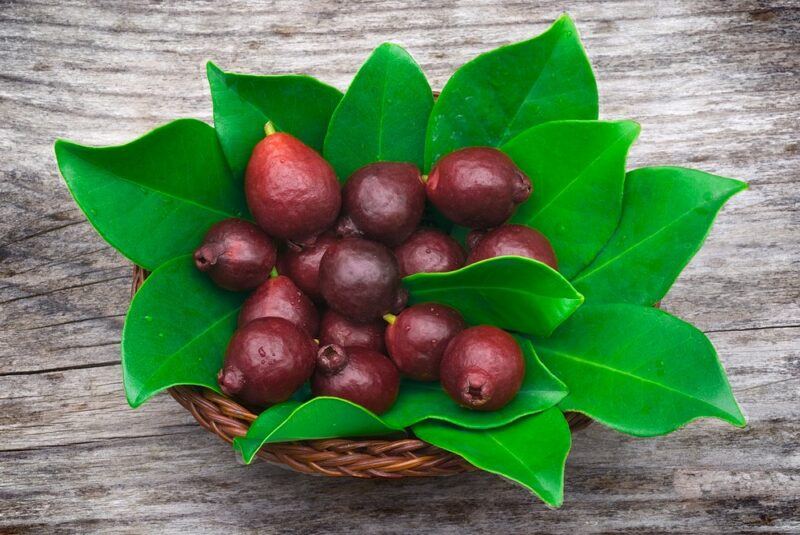
Strawberry guava fruits come from the species Psidium cattleianum and are native to South America. They do well in many environments, to the extent that they’re considered invasive species in some places, including Hawaii.
The fruits from this plant are indeed similar to the common guava, but look more stunning on the tree and taste better as well.
The fruit can easily be eaten raw without any effort. However, the seeds are tough, so it’s best to remove them. Some people swallow the seeds whole instead (doing so requires less work but perhaps isn’t the healthiest approach).
Governor’s Plum

The governor’s plum fruits are indeed much like European plums, complete with a dark purple to black coloring and familiar texture.
The plant has also traditionally been used for fencing, due to its notable thorns. However, some cutting-based plants are thornless, allowing them to be more easily grown in gardens.
Ice Apple

Ice apples are incredibly unusual. I mean, just look at the fruit. Weird, right?
The outer shell of this fruit is a little like a coconut. Opening this reveals orange or yellow pulp that covers transparent ice-looking fruit. The fruit itself has a texture much like a lychee. It is also surprisingly cooling, making it a refreshing summer treat.
The cooling feature partly comes from the high water content of the ice apple, which also makes this a hydrating fruit. It’s thought to offer a variety of important nutrients and antioxidants too. While the fruit is commonly eaten fresh, it can also be used in recipes, including desserts and ice apple milk.



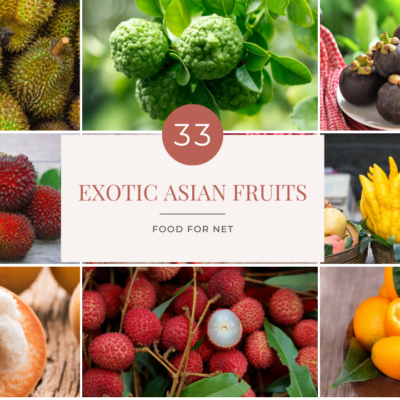









 What Is Tequila Made From?
What Is Tequila Made From?
The Philippines’ “Sampinit” (wild raspberry) should be in the list.
That’s a great idea! I’ll see if I can find a picture to use on my site.
Maybe you should add the Dalandan (native here in the Philippines aswell)
Maybe you should add the Dalandan (native here in the Philippines aswell) and a pomelo’s inside when ripe is usually light pink or a pastel pink.
You missed marang, another good Philippine fruit. Do you know anything that sounds like “russel or rocel” looks like mini dragonfruit and used for juice? Have been searching for info on this.
Apple
The one you named Genips (Spanish Lime) it’s actually called Quenepas doesn’t taste like lime at all .
The thimble berry! I has wonderful raspberry-like taste, But with tiny little drupelets. EXCeOne of my favorites! I usually find them along streams and rivers in Northern California.
you should also ad a lychee they are common in Bangladesh and are rare in England
England people sell them but they are not ripe and fresh
Pretty sure lychee was on the list already
Cupuaçu is commonly known in the production of delicious mousses, creams and juices, rich in flavors in Brazil. Chocolate from cupuaçu isn’t what it is really acknowledged for.
I love looking at these lists! I eat (and even grow) some of the fruits you have listed. A few to consider adding:
Cashew apples–common in Brazil, very sweet and often made into a juice. They’re extremely perishable, so you’ll rarely see them in markets away from countries where they’re grown.
Lemon guavas and the closely related strawberry guavas–related to regular guavas, except these fruits are small, about the size of a cherry. Lemon guavas have a complex citrus (almost vanilla-like) taste, but strawberry guavas can be a bit sour.
Babaco–this is a type of papaya from the mountains of Ecuador. This does not taste like a papaya but instead tastes like a cross between a pear and a pineapple and has yellow-white flesh.
White sapote–much different from a black sapote, this southern Mexico fruit looks a little like a green apple at first glance, but is very creamy and white on the inside. The taste is kind of a cross between a pear and a banana.
Also, there are palms other than dates and coconuts that have edible fruits, such as the jelly palms (good for jelly as the name implies but not so much as fresh fruit) or the peach palm fruits (starchy and bland, doesn’t taste like a peach, best for cooking).
Great ideas Brandt!
If the babaco is what I think it is, I would suggest poaching it, I had it poached by my friends in Ecuador when I visited and it tasted like a miracle!
Which one do you take to lose belly fat?
I like to collect exotic fruits.
I have wood apple.
Hey, I know it’s hard to find pictures, so don’t mind me if you just couldn’t. But, are you aware that the picture under “saguaro” is actually a picture of a compass barrel cactus (ferocactus wislizini)? I don’t know if you can use them on your website or not, but Wikimedia Commons does have some pictures of saguaro fruit.
Other than that, this was a great and interesting post. Thanks for making it!
Thanks for the catch! Sometimes photos are mislabeled, and you are correct, I had the wrong photos. I’ve updated them to reflect the correct fruits!
Wow, and a great new source, too! I learned like five things today (about a cactus that surrounds me, and that I study), so thanks!
I now have a huge list of fruits to be on the hunt for. See what i can find locally and save the rest for my travels overseas. Thank you for doing this list and the vegetables list. You have given me some inspiration to start cooking again. Thank you for your time and effort that went into compiling the lists.
I love this list. I was doing some reasearch on fruits and this list gave me tons of them.
why are pawpaw (asimina triloba) not mentioned? they are North Americas largest native fruit that most people have never hears of.
Nice find! I haven’t heard of those before.
It is called Papaya (in India)
Pawpaws are actually different from the papaya. Pawpaws have yellow flesh.
We also have them with a red/orange coloured flesh here in Australia and my second home in Thailand.
Known as PAW PAW in AU and PAPAYA in TH. Same fruit really …
In North America papaya (carica) has small round seeds. Pawpaw (Asimina triloba) has large seeds and is in the same family as cherimoya but is native to North America.
The Pawpaw is actually poisonous and barely safe to eat when fully ripened. Those that can eat it without getting sick are usually only able to eat 1 or 2 a day without feeling the effects.
It’s in the anonna family and perfectly edible. Toxins are in the seeds as is normal for all anonnas. Some people are sensitive to them but they aren’t poisonous.
The flesh of the Pawpaw (Asimina triloba) is not poisonous and many named cultivars exist for home orchards.
rattan fruit from philippines can be added, it has a sour taste and snake fruit like exterior skin but more small and round.
What is a snake fruit?
Genips (genipa) are pretty popular in the Caribbean when in season. Here is a Wikipedia link.
https://en.wikipedia.org/wiki/Melicoccus_bijugatus
Nice! Thanks man. Will have to update the list with some photos soon.
I’m loving all the suggestions in the comments from readers.
We call them Quenepas in Puerto Rico
lovely list!
i would add two fruits, one i found growing on trees in Uganda, called Jambula
and also there i found but as an import, jujube berries on the bush.
both very delish!
Nice! Thanks for the additions. I’ll look those up!
Wonderful photos and descriptions !
I did not find my mystery fruit which ripens in early April here in S. California. It comes from a huge tree with a compound leaf that has 3 narrow leaves at the tip of the petiole (leaf stem).
It is light green in color and resembles a small apple and has whitish flesh.
Take photo and submit to the app iNaturalist. Probable ID will be forthcoming!
Milk fruit? or milk apple? we had something like that in Cambodia, not sure about the scientific name.
Great idea this whole collection of exotic fruit though!
Star apple i think.
An excellent effort… there should be an easy exchange of fruit and vegetables seeds among different areas of the world.. so that people may taste the tastes of the nature… n may have benefits of variety of fruits which God has bestowed human..
Totally agree..!!!
You are so unlucky, I live in Ecuador and I literally have Guaba trees or you will call them Pacay / Guama trees all over my neighborhood and I have a giant one in my house.
You used the same picture for the Caimito as you did the lucuma, oops!
I’ll keep an eye out for some of these in stores!
Another fruit you can add to the list are tamarillos!
Love it. Thanks!
I have a few that I feel should add to that list 😊
Matohwe (snot apple)
Mawuyu baobab fruit
Tsubvu (waterberry??)
Nhengeni (Sour plum)
Nyii (Bird plum)
All native to Zimbabwe 🇿🇼
Nice list. I really want to try a snot apple now LOL
Excellent list, just what I was looking for! I breed Fancy mice and my naming theme is fruit. It was easy when I got my first breeding trio (Mango, Papaya and Kiwi) but now that I’m up to 40+, I thought I was running out of fruit! This list will help for quite a while, but I think I may need to eventually expand my theme… Any chance you have a list of nuts or something?
Great Idea! I’ll have to make a nuts list.
Definitely include Mongongo nut, from Africa. Nutritious and locally nutritionally important.
This is a great website! I love exotic fruits and this has shown me so many new one as well as a handful that I have tried or heard of!
I suggest that you add the cocoa fruit to this website (it’s one of my favourite fruits of all time!!) and the many types of banana that you can’t commonly find in places like The States or Canada! On another note, I have to question the exoticness of the salmon berry. it’s true that I have never seen it in stores, but where I live if you go just outside the city there are tons and tons of salmon berry bushes! You can find them in B.C, Washington State, and maybe Oregon along the coast and possibly further inland.
Hope this was helpful!
Great list! Please add that Ackee must be cooked before it is eaten.
Just stumbled upon this great list! Am lucky to live in the tropics so have had a chance to taste many of these fruits. I now have 10s of new varieties I need to try. Some additions you could consider to this list –
1. The Ice apple or Toddy palm fruit – Refreshing and cool in the summers (http://www.hydnews.net/munjal-or-ice-apple-is-a-pure-summer-fruit-with-several-health-benefits-and-natural-remedies/)
2. The Phalsa berry which is made into summer coolers and can be eaten fresh of the trees ( https://en.wikipedia.org/wiki/Grewia_asiatica )
3. The Carandas cherry or Karonda – small reddish purple fruit slightly tart. Delicious with some rock salt
4. The Ambarella or Amra fruit – crunchy and slightly tart when semi ripe but so good to eat! ( https://en.wikipedia.org/wiki/Spondias_dulcis )
Please consider the following:
1. Coconut
2. Tamarind
3. Mabolo
4. Cashew
5. Guamuchil or Manila tamarind
6. Mango
7. Ambarella or Hog Plum
8. Barbados cherry
9. Cherry of the Rio Grande
10. Grumichama
11. Jamaican strawberry or Aratiles
12. White sapote
13. Hog plum or ciruela
14. Papaya
15. Passion fruit
forgot vitoria , lovely sharp, tangy fruit with bit of chilly powder
Every other week or so myself & 3 daughters went on quests to find exotic fruits & berries to try. We explored aroma, texture & taste. Many we loved, but all agreed the rambutan was sweet but we couldn’t get past the texture or look. It felt much like a peeled grape an looked too much like an eyeball LOL I’m anxious now to try some of the fruits in your wonderful list! Thank you!
The yangmei and the strawberry tree look like the corbezzoli we have in Sardinia. They are sweet and soft and grow on trees, if you eat too many they can give you slight food poisoning though and make you sick 😷 in Sardinia we are avid eaters of prickly pears as well and for us is actually the opposite, we eat the fruit but don’t know what to do with the leaves. You pick them with a forked bamboo stick and just use a fork and a knife to peel them and eat them safely. You are also supposed to rub them under your sole in the grass when you pick them to remove some of the spines.
Wow! Thanks so much for putting this comprehensive list together. Fascinating to learn about so many fruits I’ve never hard of and others I’ve seen but haven’t tried yet.
Thank you! I learned so much, and identified my SantolTree with the help of your site! I’m in Hawaii so I have a lot of great species on my land. Maybe you want to add on a red mambin, and mabolo fruits to your list!
I think though that your listing of rose Apple, looks to me like a picture of a mountain Apple as far as what we called them in Hawaii, a rose apple is smaller rounder and not very bright flash, and it totally tastes and smells like a rose! Thank you so much for your help, Mahalo Nui!
I’ve never heard of a rose apple. Interesting!
Consider adding:
Gooseberry, very delicious, also use to make jams
Barbados Cherry
Governor Plum
Cherise Cherry
all of these are found in Trinidad, and throughout the West Indies.
thanks
Is there anybody here willing to send me seeds to try and propagate these rare fruits in South Africa?
We have got a Kei apple that is divine – I have just gotten some seedlings growing from seeds. May be worth adding to this wonderful list.
i wonder about persimmon quince andbarberry
weird are iceberry barberry sapote lingonberry
ugli fruit
Great list! But I’d like to add balata, barbadine, pommecythere, and portugals to this list. They’re found in the Caribbean (as are quite a few of the fruits on this list), though they might be known by different names throughout the islands.
P. S- if you want to try the ice-cream bean again, it’s called “padoo” in Trinidad, and it’s very cheap here
Great additions Annelise. I love all the additions from the commenters from around the world.
Food for net could you add a berries list please🧐🦗🐿🧛♂️🇹🇷☪️🍓
Great idea!
Here are the berries food for net .add iceberry bear bill soap glue bar snow sea bay berries please please шќкд лем рл рлл. Домче елен фкр.ẅìyuÿ iospãé
Thank you for this awesome list – I can’t wait to go find some of these fruits and try then!
I had a fruit called ‘granadilla’ in Colombia a couple years ago and it was delicious. Texture is a bit odd to some, but taste is worth it, IMO.
Thank you for the wonderful list and photos of exotic fruits around the world! How wonderful nature is!!! See Mo’s comment above about about Granadilla. I’m living in South African and here it is common, but I didn’t see it above.
Vietnamese FISHEGGS FRUITS OR Berries I am sure what u call,but they are good.
I lived in San Antonio Texas there was a tree that grew outside of my barracks that produced a black skin when ripe. It was about 3 to 4 inches long an had a yellow to white flesh with black seeds. The flesh had a custard like taste an the seeds were inedible. Any ideas on what it could be called? I thought it was a pawpaw but im not sure after reading the pawpaw description
I saw a picture of an item hanging from a branch looking like a lacey heart with a stem and a seed of some sort inside.I cannot find any reference to it anywhere. Just wondered if anyone else has seen it.
Thank you for the massive info! I live in the tropic and not familiar with most of these fruits mentioned. Thank you for the great information!
Just tried lychee for the first time & I am in love with it. Had Pichu berries when I was in Arizona. I have watermelon berries & Nagoon berries growing up here in Alaska. Watermelon berries are very seedy & can be confused with something poisonous. The Nagoon berries are ground plants that taste like raspberries, but much smaller. The birds get them long before I do.
Watermelon berries? Weird! I haven’t heard of those before. I checked them out. They look a little like coffee beans IMO, but you are right that they look pretty close to a lot of other berries out there so I’m not sure I’d want to pick them in the wild.
If you like lychees, you’ll also like longans.
Have A Good Day
Mabolo fruit of relative of Persimmon but native in Philippines. It is also called velvet apple.
Missing sinigguelas and kamatshili from the Philippines
Thank you for another great list of uncommon foods!
Do you know where a blend of these exotic fruits might be available in powdered / dried form?
Thank you !
There’s also Che (Cudrania Tricuspidata) which is in the mulberry family and is native to northern China.
And Deadman’s fingers (Decaisnea fargesi) which has blue finger shaped fruit.
Was disappointed that Guayaba and Passionfruit were not on your otherwise wonderful and informative list.
When I lived in Bali for about a year, back in the 70s, I could sometimes find a fruit the locals called “Kepundung.” It looked a lot like your photo of Longan. The fruits were round, small (about the size of an American 25¢ piece (quarter). The fruit hung off a very woody stem, grape-like, but in long bunches. The taste was a bit tangy, absolutely delicious. But I remember the fruits being more yellow in color and not that woody brown of the Longan.
Any clue as to what fruit it was I was eating? It wasn’t all that common, I know that. Thank you.
(And —– Mangosteen. That’s the fruit I miss the most.)
And *thank you* for putting together such a comprehensive list of exotic fruits. There are so many I would love to try.
Thanks for a great list! Sent to me by a friend. In Ecuador currently. Daily fruit plates often include fruits unknown to us. I have a strawberry tree on my property (Pacific Northwest) and always thought the fruit was inedible.
I love this site! Glad I found it..got to try these when I can find them. THANK YOU!!
Genip is correct (Melicoccus bijugatus); and there are sweet and sour cultivars as well. You might add scientific names to prevent confusion, easily found on Google. An interesting, useful and commendable piece of work.
You didn’t include hachiya persimmons, only fuyu, which are quite different.